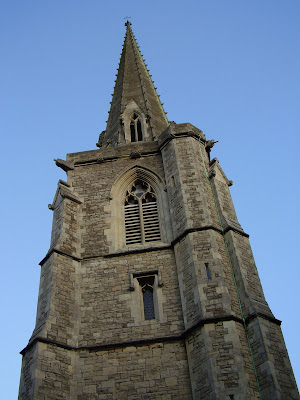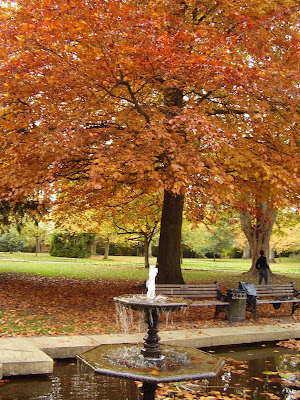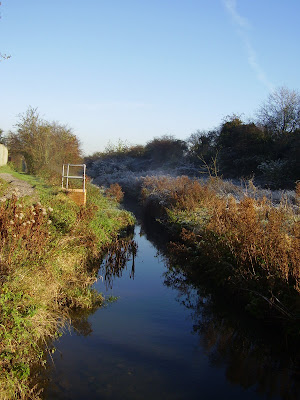Sunday, 25 November 2007
Old Town Railway Cutting

Tucked away a few minutes walk from the Old Town Gardens, this is one of Swindon's most fascinating little spots - it forms part of the Railway Walk which used to be the Wootton Bassett to Marlborough line.
The Old Town Railway Cutting rocks are between 155 and 145 million years old and date from the Jurassic seas which once covered Swindon. They comprise:
- Swindon sand and stone - a yellow sandstone jutting out of the top of the rock face.
- Cockly Bed - a knobbly limestone so called because it contains countless numbers of fossil cockle like shells. Formed on the great banks coating a shallow tropical sea floor.
- Glauconite Beds - a sandy limestone, so called because it contains the microscopic mineral glauconite which gives a green colour to fresh surfaces. Laid down in the shallow warm sea about 150 million years ago.
 Swindon Sand and Stone
Swindon Sand and StoneThursday, 15 November 2007
Millennium Bridge - the end of a peaceful walk

This very peaceful scene shows the upper end of the Kingshill Canal and denotes the end of the walk as the path alongside this section is closed to walkers.
Very sadly (in my view and the view of many local people) the land on the right hand side of the canal is now being developed - walk along here and weep at what has been lost - a beautiful stretch of farmland with the river Ray running through it, forming what was known as the Front Garden between the ever expanding town and the motorway. Small herds of red deer could frequently been sighted. I wonder where they have gone ........
This little bridge was rebuilt with Cotswold stone for the year 2000 to mark the Millennium. The small blue plaque on the side is a Heritage Award.
Very sadly (in my view and the view of many local people) the land on the right hand side of the canal is now being developed - walk along here and weep at what has been lost - a beautiful stretch of farmland with the river Ray running through it, forming what was known as the Front Garden between the ever expanding town and the motorway. Small herds of red deer could frequently been sighted. I wonder where they have gone ........
This little bridge was rebuilt with Cotswold stone for the year 2000 to mark the Millennium. The small blue plaque on the side is a Heritage Award.
Kingshill Canal - a bright frosty November morning
This frosty November morning down by Kingshill Canal has a touch of magic about it. Only a ten minute walk from the centre of town, it is incredibly peaceful - a variety of waterfowl, including a pair of young swans have happily made it their home. The ancient hedgerows along the tow-path support many varieties of 'garden' birds. This morning I saw chaffinches, blackbirds, a robin and a hedge-sparrow. Plus a pair of collared doves and quite a few contented pigeons.
On the other side of the ancient hedgrow which largely comprises hawthorns and ivy covered trees is Rushy Platt Nature Reserve. One of Swindon's unsung little corners of protected and preserved wild-life.
 The ducks waking up to a bright and frosty morning
The ducks waking up to a bright and frosty morningA frosty morning at Rushy Platt Nature Reserve
One of Swindon's two small rivers - the other being the river Cole

 Rushy Platt Nature Reserve - managed by Wiltshire Wildlife Trust
Rushy Platt Nature Reserve - managed by Wiltshire Wildlife TrustA unique wetland site and remnant of marshland that once covered most of south Swindon. The river Ray runs through its centre and it is the home of the water vole, reed warbler, great crested newts, toads and frogs. In the summer, wetland flowers such as common valerian flourish.
Sunday, 11 November 2007
Day of Reflection - Golden Oldies

 These two very mature silver birches stand in the garden of the Old Vicarage on Bath Road. The lovely red brick Victorian building used to be the vicarage for Christ Church in Old Town. When that was relocated to a building next to the church the Old Vicarage stood derelict for many years before being bought by a housing association and converted into retirement flats. (My dear mother now lives there - which is how I got to take a picture of these two golden oldies today).
These two very mature silver birches stand in the garden of the Old Vicarage on Bath Road. The lovely red brick Victorian building used to be the vicarage for Christ Church in Old Town. When that was relocated to a building next to the church the Old Vicarage stood derelict for many years before being bought by a housing association and converted into retirement flats. (My dear mother now lives there - which is how I got to take a picture of these two golden oldies today).A poem for Armistice Day
Everyone Sang - by Siegfried Sassoon
Everyone suddenly burst out singing;
And I was filled with such delight
As prisoned birds must find in freedom
Winging wildly across the white
orchards and dark-green fields; on; on; and out of sight.
Everyone's voice was suddenly lifted,
And beauty came like the setting sun,
My heart was shaken with tears; and horror
Drifted away ... O but every one
Was a bird; and the song was wordless; the singing
will never be done
Saturday, 10 November 2007
Lest we forget - Remembrance Sunday
No longer used as a chapel and has been quite badly vandalised in the past. A beautiful little building, it is opened up on the days that nature activities take place in the cemetery - which has now been designated as a nature reserve (see October's posts for more information)
This cross stands in remembrance of the fallen from the Great War of 1914 -1918. There are several war graves in this historic little cemetery, over-looking the busy town. On Sunday 11th November at 11.00am there will be 2 minutes silence at the War Memorial in the town centre and across the country. The 18th Div. Boy Scouts had a small ceremony on Saturday 10th November when they laid the poppy wreaths in this photograph.
This post is in remembrance of the much loved
SAMUEL CLIFFORD JACKSON
born 14th September 1918 - died 24th July 2000
He served his country in the Second World War
as a Royal Engineer and Commando
and spent three years as a POW.
'I pray thee then, write me as one who loves his fellow men'
(from Abou ben Adhem - by Leigh Hunt)
Thursday, 8 November 2007
The calm before the storm
 The leaves in their coppery hues still cling to these elegant trees at the Lawns (see October post). A mature beech and oak almost intertwined. The November wind was picking up and the leaves swirling - a couple of hours later there would be a hefty shower to bring the leaves tumbling down.
The leaves in their coppery hues still cling to these elegant trees at the Lawns (see October post). A mature beech and oak almost intertwined. The November wind was picking up and the leaves swirling - a couple of hours later there would be a hefty shower to bring the leaves tumbling down.The Swindon Advertiser publishes a monthly column called Nature Notes where they print seasonal extracts from the work of local 19th century writer Richard Jefferies. Yesterday (7th November) they published an extract from 'Hodge and His Masters' written in 188o.
So there are days to be enjoyed out of doors even in much-abused November. And when the wind rises and the storm is near, if you get under the lee of a good thick copse, there is a pleasure in the frenzy that passes over.
With a rush the leaves stream outwards, thickening the air, whirling round and round; the treetops bend and sigh, the blast strikes them, and in an instant they are stripped and bare.
This tiny little building at the Lawns is thought by some to be a folly - it was in fact an Ice House with ice stored there for use by Goddard family who owned of the Manor House which once stood in the grounds of the Lawns. The Manor House was demolished after the Second World War but the grounds are now a much loved and beautiful parkland space for the pleasure of local people.
Wednesday, 7 November 2007
Cambria Place
 Cambria Place - separated from the main Railway Village by the now busy Faringdon Road, it was once very much part of the railway community. A part of 'hidden' Swindon tucked away at the very heart of the town. See the entry on Chapels for more on the fascinating history of this little community of houses - originally named after the Cambrian Mountains of Wales.
Cambria Place - separated from the main Railway Village by the now busy Faringdon Road, it was once very much part of the railway community. A part of 'hidden' Swindon tucked away at the very heart of the town. See the entry on Chapels for more on the fascinating history of this little community of houses - originally named after the Cambrian Mountains of Wales. Cambria Place was a later addition to the Railway Village built in the late 1860s - it is now in the part of a busy residential area in the centre of Swindon with a busy one-way traffic system running ajacent to it. Back in the 19th and early 20th century the long back gardens would have been used as small holdings for livestock, fruit-trees and vegetables. As can be seen in the foreground of the above picture, one of the gardens is still used to raise a few free range chickens. The gardens back onto what would have once been the Swindon canal. Although a small section remains, this part of the canal has now been filled in and is a footpath to the town's main shopping centre.
Cambria Place was a later addition to the Railway Village built in the late 1860s - it is now in the part of a busy residential area in the centre of Swindon with a busy one-way traffic system running ajacent to it. Back in the 19th and early 20th century the long back gardens would have been used as small holdings for livestock, fruit-trees and vegetables. As can be seen in the foreground of the above picture, one of the gardens is still used to raise a few free range chickens. The gardens back onto what would have once been the Swindon canal. Although a small section remains, this part of the canal has now been filled in and is a footpath to the town's main shopping centre. This little community was the first in Swindon to have piped running water.
Railway Village - Chapels
The grandest of the chapels in the Railway Village. This once magnificent building later became the Railway Museum housing steam engines. Today, with the opening of the relatively recent STEAM Museum, it is now a community centre.
This extract of historical information has been submitted by Eileen George and taken from Roadways - The History of Swindon Streetnames by Peter Sheldon and Richard Tomkins
The small stone cottages of Cambria Place were built in the 1860s to accommodate the influx of Welsh iron-workers who were brought to Swindon when the GWR rolling mills opened. The name is taken from the mountains of their homeland.
So scarce were the houses at the time that it proved impossible at first to house the workers. Fortunately the GWR had erected a building known as the Barracks (subsequently the Wesleyan Chapel) as a community dwelling house and the Welsh immigrants took up residence ......
Nearly all the Welsh families transferred to Cambria Place when it was completed in 1864. The 1865 Rate Book records the settlement as "Welsh Colony". For many years services at the tiny Baptist Chapel here were conducted entirely in Welsh.
Tuesday, 6 November 2007
The Cricketers - Emlyn Square
A part of Brunel's Railway Village and originally its only fully licensed house, the Cricketers opened its doors in 1847. The name came from its proximity to the Cricket Field (now known as Faringdon Road Park).
The Railway Village - St. Mark's Church
After the Railway Village was built in the early 1840s for the railway workers and their families, the need for a church was considered an urgent necessity.
St Mark's Church was designed by Sir Gilbert Scott who also went on to design St Pancras Hotel and Station, the Albert Memorial and St Mary's Cathedral in Edinburgh. The church was dedicated on the feast of St Mark on 25th April 1845.
 The Spire - St Mark's
The Spire - St Mark's St Mark's Church - Railway Village
St Mark's Church - Railway Village St Mark's Church seen from Faringdon Road Park
St Mark's Church seen from Faringdon Road ParkIn 1844, land west of the new Railway Village and the church was purchased by GWR from Lt. Col. Vilett, a local land-owner for use as a cricket ground. A pavilion was built on the north side of the site and the New Swindon cricket team played there from 1847. The park became known as the Cricket Fields and in later years was also known as the Plantation and Victoria Park. Unfortunately the ornamental gardens, cricket pavilion, bandstand, drinking fountain, lodge and glass-houses no longer exist.
The Railway Village
Early November - still adorned with autumnal beauty
 A burnished beech tree by the ornamental fountain in the Town Gardens on a quiet Saturday afternoon in early November.
A burnished beech tree by the ornamental fountain in the Town Gardens on a quiet Saturday afternoon in early November.
Subscribe to:
Comments (Atom)



























